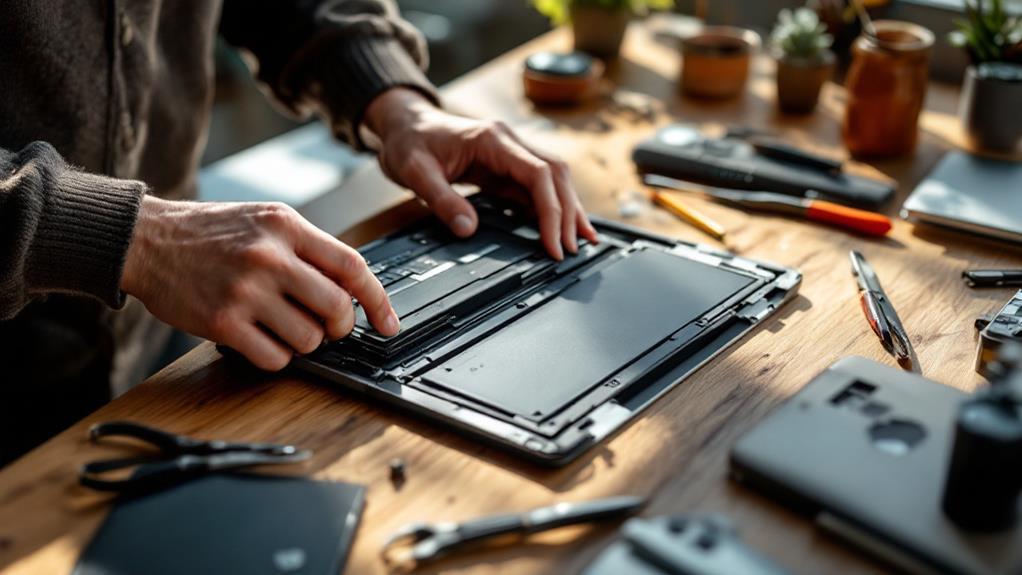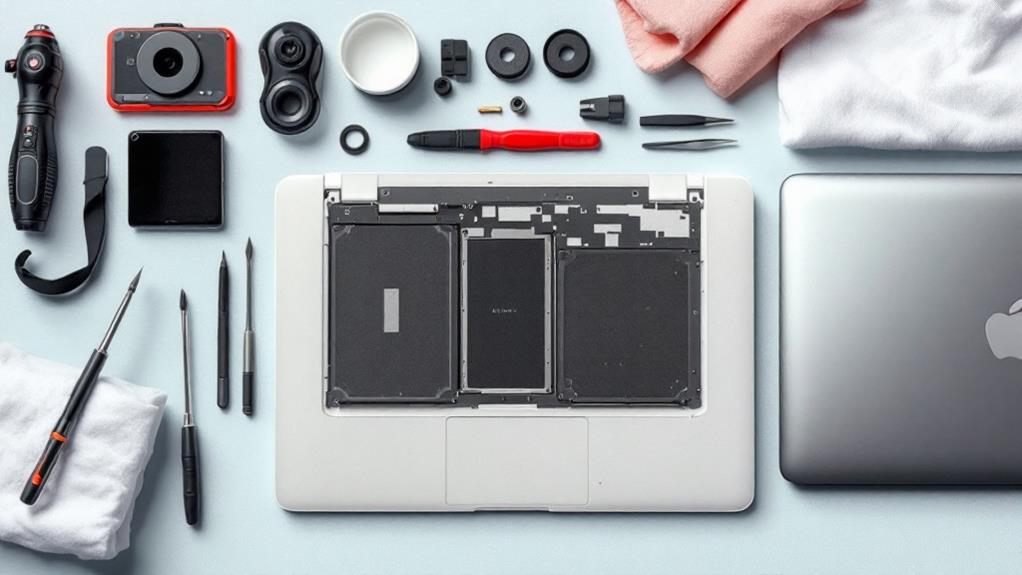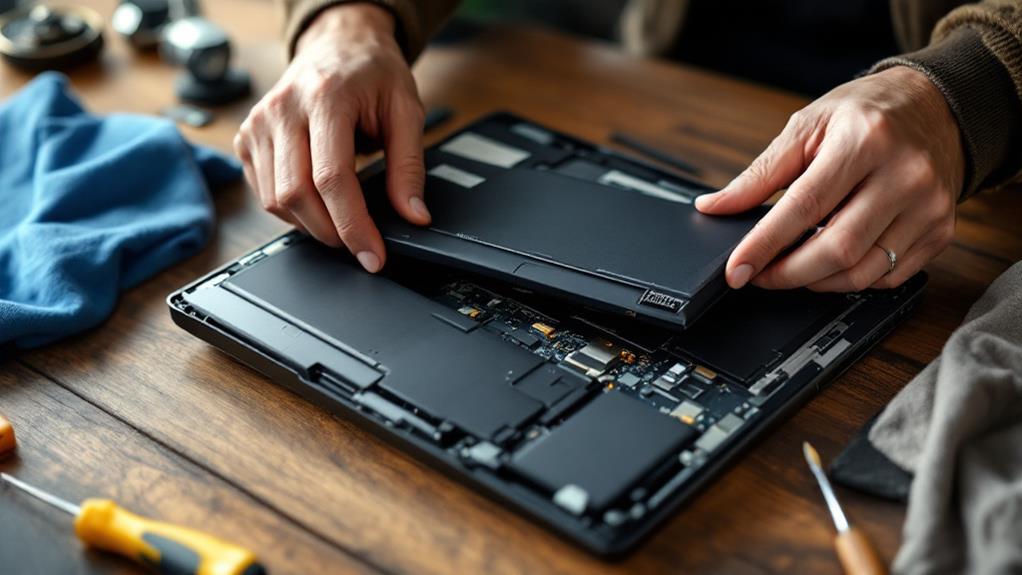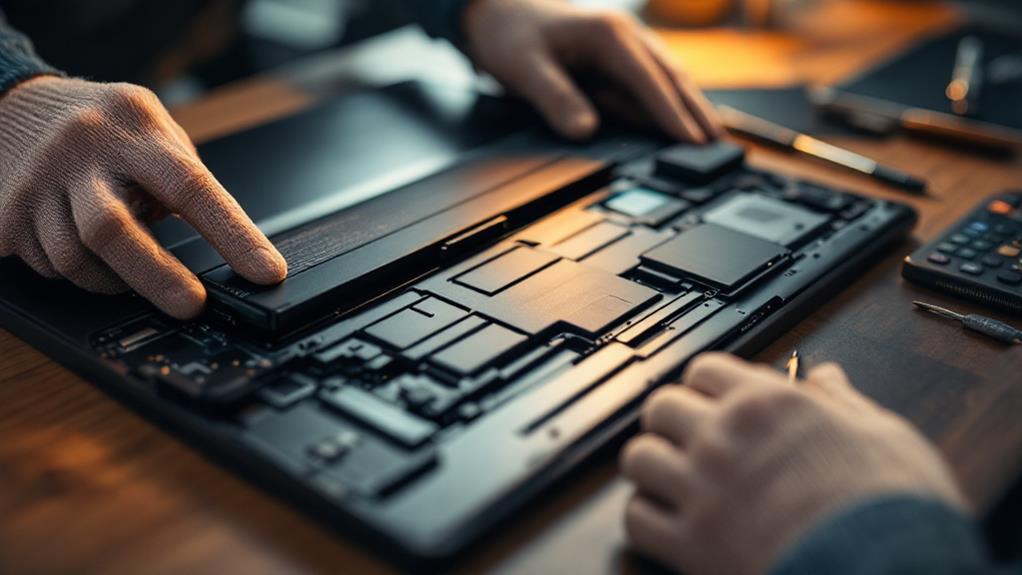Tips for Replacing Your Laptop Battery: A Quick Guide

To replace your laptop battery, start by identifying your laptop model to verify compatibility with the new battery. Double-check the battery type and voltage ratings. Gather tools like a Phillips head screwdriver and an anti-static strap. Fully power down and unplug your laptop. Remove the old battery carefully, using gentle force, and avoiding any damage. Place the new battery in, making certain it's aligned and secured. After installation, test the new battery for proper functionality and performance. Dispose of the old battery responsibly. By following these steps, you'll uncover more about optimizing your laptop's battery life.
Identify Your Laptop Model
Knowing your laptop model is crucial before replacing the battery. You can't just pop into a store and grab any battery; initially, make certain you're well-acquainted with your device's specifics. Understanding laptop identification methods will save you from future headaches and guarantee compatibility with the new battery.
Start by checking the laptop's underside. Manufacturers often place a label there with the model number clearly printed. If that's not visible, power on your laptop and head to the system settings or BIOS menu. Here, you'll usually find detailed information about your model. Model specification importance can't be overstated; it confirms you don't waste time or money on incompatible parts.
Another method involves looking at the original packaging or any documentation that came with your laptop. If these are long gone, consider visiting the manufacturer's website. Many brands offer tools or support pages dedicated to helping you identify your model based on serial numbers or other unique identifiers.
In some cases, you might find model numbers under the battery compartment itself. So, if you're comfortable with it, gently remove the battery to check. These laptop identification methods assure you know precisely what you're dealing with before proceeding.
Check Battery Compatibility
Verifying battery compatibility is a vital step in the replacement process. Before you make a purchase, confirm that the new battery is compatible with your laptop model. Start by identifying the battery type your laptop uses. Common battery types include Li-ion and Li-polymer. These types dictate characteristics like lifespan and charging behavior. Check the specifications of your current battery, often found on a label attached to it.
Pay close attention to voltage ratings, as these are essential for guaranteeing the new battery functions correctly with your laptop's hardware. Mismatched voltage ratings can lead to issues, from suboptimal performance to potential damage to your laptop. Your laptop's current battery will typically have its voltage rating printed on it, often in volts (V). Make sure the replacement battery matches this exactly.
Also, consider the battery's physical dimensions to ascertain it fits snugly in your laptop. Manufacturers' websites or your laptop manual can provide detailed information on compatible batteries. If you're uncertain, it's wise to consult the manufacturer's customer support for guidance. By verifying compatibility details, you'll avoid the hassle of returns and guarantee your laptop operates smoothly with its new power source.
Gather Necessary Tools

Once you've verified your battery's compatibility, you'll need to gather the tools required for the replacement process. Having the right tools not only guarantees a smooth battery swap but also plays a vital role in battery maintenance and general laptop longevity. Start by grabbing a small Phillips head screwdriver. Most laptops require this to access the battery compartment. However, some models might need a Torx screwdriver, so check your laptop's manual for specifics.
You'll also want a plastic spudger or pry tool. This helps safely open your laptop without scratching or damaging its surfaces. Avoid using metal tools for this task, as they can cause unintended harm to delicate components.
An anti-static wrist strap is another important tool. It prevents static electricity from potentially damaging your laptop's internal components during the replacement. If you don't have one, make sure to ground yourself by touching a metal object before starting.
Lastly, keep a soft cloth or microfiber cloth handy. It's useful for cleaning any dust or debris that might have accumulated in the battery compartment, guaranteeing a clean connection and maximum performance. With these tools in hand, you're ready for a successful battery replacement.
Power Down and Unplug
Shutting down your laptop completely is a crucial initial step in safely replacing the battery. This guarantees you're not risking any electrical shocks or data loss while you work. Powering down also aids in maintaining your battery lifespan, as it prevents unnecessary drain during the replacement process. Once your laptop is fully off, unplug it from any power source. Leaving it plugged in can not only be hazardous but may also affect your charging habits and general battery performance.
It's vital to keep in mind that proper charging habits contribute considerably to battery lifespan. By disconnecting from power during the replacement, you're promoting a more stable environment for your battery. This simple step can help avoid issues like overcharging, which can degrade battery health over time.
After unplugging, take a moment to inspect your power adapter and cables. Make sure they're in good condition, as faulty connections can impact charging efficiency and battery lifespan. If you notice any fraying or damage, consider replacing them. By being mindful of unplugging and power management, you set a solid foundation for extending your laptop's battery lifespan and facilitating a smooth replacement process.
Remove the Old Battery

Removing the old battery is a straightforward process, but a few precautions will assure everything goes smoothly. To begin, verify your laptop is completely powered down and unplugged; safety should always come first. Locate the battery release latch, usually found on the bottom of the laptop. Once you've found it, gently slide or push the latch to release the battery. If your laptop has screws securing the battery, use a screwdriver to carefully remove them.
Before you proceed, here's a quick emotional checklist to inspire confidence and readiness:
- Excitement: You're extending your device's battery lifespan, giving it a new lease on life.
- Relief: No more worrying about poor charging habits affecting performance.
- Empowerment: You've got the skills to tackle tech challenges head-on.
- Satisfaction: Enjoy the reward of a longer-lasting, more reliable laptop.
Once the old battery is released, carefully lift it out of its compartment. Remember to handle it gently, as old batteries can sometimes swell or leak. This removal process gives you the perfect opportunity to reflect on your charging habits and consider how they impact your battery lifespan. By doing so, you'll set yourself up for success with your new battery.
Install the New Battery
With the old battery safely removed, you're ready to breathe new life into your laptop by installing the fresh battery. Initially, verify that the new battery matches the specifications of the old one. A perfect fit is essential for peak performance and extending your battery lifespan. Check the connectors on both the battery and laptop to confirm compatibility.
Begin by aligning the battery with the designated compartment in your laptop. Use gentle pressure to slide it into place, making sure the connectors are securely attached. You'll often hear a click, signaling a successful connection. This simple yet effective installation technique assures that your battery is properly secured.
Next, double-check that the battery is flush with the laptop's surface. A snug fit prevents potential dislodging during use. If your battery has screws, use a screwdriver to fasten them carefully. Avoid overtightening, as it can damage the casing or strip the screws, negatively affecting the battery lifespan.
Take a moment to inspect the installation. Confirm there are no gaps and that the battery sits securely. With these steps, you've effectively installed your new battery, preparing your laptop for dependable performance.
Test the New Battery

Now that your new battery is installed, it's time to test its functionality to confirm your laptop runs smoothly. Begin by powering on your laptop and observing how quickly it boots up. This is your primary indication of battery performance. If everything seems normal, move on to the next steps to verify maximum functionality.
- Check Battery Life: Fully charge your laptop, then unplug it and let it run until the battery is low. This helps you evaluate the new battery's longevity. If it drains too quickly, there might be an issue.
- Monitor Charging Speed: Plug your laptop back in and note how long it takes to reach a full charge. A slow charging process could signal a problem with battery performance.
- Run Stress Tests: Use your laptop as you normally would, running programs and applications to test how well the battery holds up under strain. This will highlight any potential issues under load.
- Observe Temperature: Feel the bottom of your laptop for excessive heat during use. Overheating can indicate a malfunction and needs immediate attention.
If you encounter any irregularities, refer to troubleshooting tips specific to your laptop model to address the problem effectively.
Properly Dispose of Old Battery
Proper disposal of your old laptop battery is vital for environmental safety and compliance with local regulations. When you toss a battery in the trash, it poses significant battery hazards. These hazards include leaking harmful chemicals and metals into the soil and water, threatening wildlife and human health. Instead, opt for recycling options, which are both safe and environmentally responsible.
Start by checking with the manufacturer of your laptop. Many companies offer take-back programs to recycle old batteries properly. These programs guarantee that the materials are handled correctly and don't end up in a landfill. You can also look for local electronic waste recycling centers in your area. These centers are equipped to handle battery hazards and guarantee safe processing.
Retail stores like Best Buy or Staples often provide drop-off bins specifically for battery recycling. It's convenient and helps keep your community environmentally friendly. If you're unsure where to go, websites like Call2Recycle can point you to nearby recycling options.



